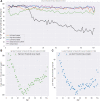Real-World Evidence and Glycemic Improvement Using Dexcom G6 Features
- PMID: 33434439
- PMCID: PMC7957382
- DOI: 10.1089/dia.2020.0654
Real-World Evidence and Glycemic Improvement Using Dexcom G6 Features
Abstract
Background: Optional features of continuous glucose monitoring (CGM) systems empower patients and caregivers to understand and manage diabetes in new ways. We examined associations between use of optional features, demographics, and glycemic outcomes. Methods: Retrospective cohort studies were performed with data from US-based users of the G6 CGM System (Dexcom, Inc.). For all cohorts, data included sensor glucose values (SGVs). In separate cohorts, use of alert features (for hyperglycemia, existing hypoglycemia, and impending hypoglycemia), remote data sharing feature (Share), software for retrospective pattern analysis (CLARITY), "virtual assistant" feature that announces the current SGV and trend in response to a spoken request were assessed. Descriptive statistics were used to summarize feature set utilization patterns and relate them to glycemic outcomes. Results: Most individual features were consistently adopted by high proportions of G6 users. Threshold SGVs chosen for activating hyperglycemia and hypoglycemia alerts varied with age and were higher among the youngest and oldest patients. Use of the Share feature was more common among young patients and those with type 1 diabetes. Individuals who used more of the alert and notification features had more favorable glycemic outcomes, including time in range (TIR), than those who used fewer. More extensive engagement with CLARITY notifications was associated with higher TIR. Frequent use of the virtual assistant feature was associated with higher TIR and lower mean SGV. Conclusions: Optional features of the G6 CGM system are acceptable to and appear to benefit patients who use them. Different levels of engagement suggest that demographics and personal circumstances play a role in how patients and caregivers use CGM features to help manage diabetes.
Keywords: CLARITY; Continuous glucose monitoring; Dexcom; Real-world data; Type 1 diabetes.
Conflict of interest statement
H.K.A. received research support through University of Colorado from Dexcom, Senseonics, Eli Lilly, REMD, IM Therapeutics, and Mannkind, and honoraria from the American Diabetes Association. R.D., K.S., and M.D. are employees of Dexcom, Inc.
Figures

References
-
- Beck RW, Riddlesworth T, Ruedy K, et al. . Effect of continuous glucose monitoring on glycemic control in adults with type 1 diabetes using insulin injections: the DIAMOND randomized clinical trial. JAMA 2017;317:371–378 - PubMed
-
- Lind M, Polonsky W, Hirsch IB, et al. . Continuous glucose monitoring vs conventional therapy for glycemic control in adults with type 1 diabetes treated with multiple daily insulin injections: the GOLD randomized clinical trial. JAMA 2017;317:379–387 - PubMed
-
- Beck RW, Riddlesworth TD, Ruedy K, et al. . Continuous glucose monitoring versus usual care in patients with type 2 diabetes receiving multiple daily insulin injections: a randomized trial. Ann Intern Med 2017;167:365–374 - PubMed
-
- Garg SK, Akturk HK. A new era in continuous glucose monitoring: food and drug administration creates a new category of factory-calibrated nonadjunctive, interoperable class II medical devices. Diabetes Technol Ther 2018;20:391–394 - PubMed
Publication types
MeSH terms
Substances
LinkOut - more resources
Full Text Sources
Other Literature Sources
Medical
Research Materials
Miscellaneous
